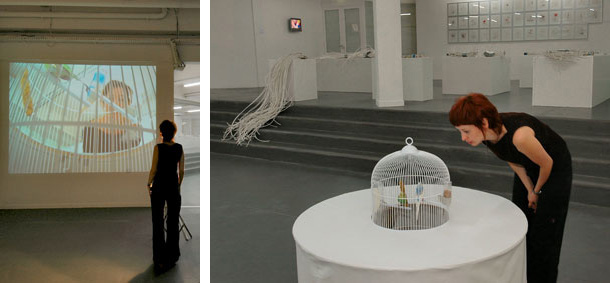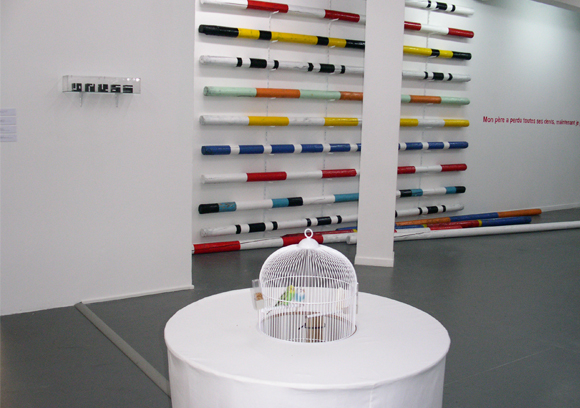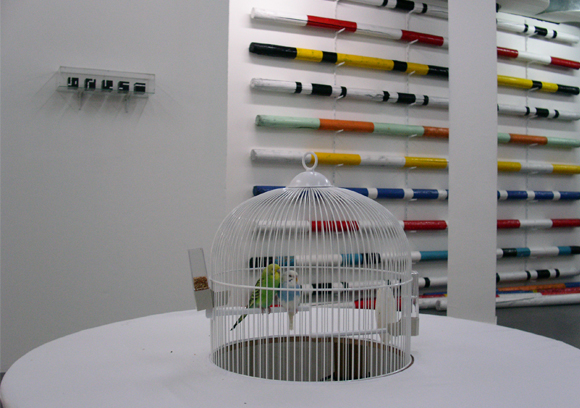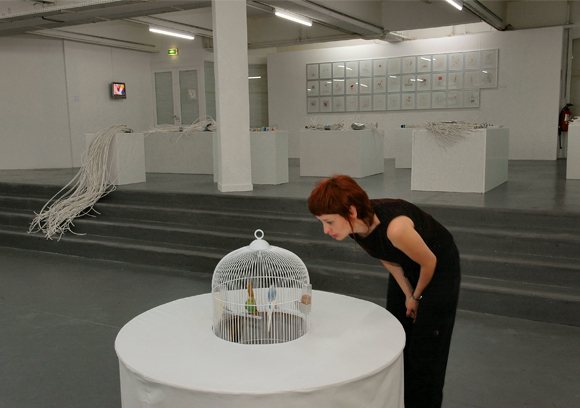| |
|
|
09.
| Birds language |
| |


2001-2004, mixed media, sound installation,video transmission, size may vary.
Exhibition view of Comprendra bien qui comprendra le dernier, Le Parvis, 2004, Ibos.
Courtesy of the artist and Ceysson & Bénétière, Paris.
Ed. of 5 + 1 A.P.
'' The work encourages moving around and is an invitation to travel in order to attain openness and unity. It suggests to go out and meet the world, other people and oneself,
drawing from sources of inspiration and methods of approach combining philosophy and poetry, intellectual precision and sensitivity. ''
Studio Fatmi, August 2017

Birds language
Exhibition view of Comprendra bien qui comprendra le dernier, Le Parvis, 2004, Ibos.
Courtesy of the artist and Ceysson & Bénétière, Paris.

Birds language
Exhibition view of Comprendra bien qui comprendra le dernier, Le Parvis, 2004, Ibos.
Courtesy of the artist and Ceysson & Bénétière, Paris.

Birds language
Exhibition view of Comprendra bien qui comprendra le dernier, Le Parvis, 2004, Ibos.
Courtesy of the artist and Ceysson & Bénétière, Paris.
|
|
|
|
|
|
Le langage des oiseaux est une installation qui se déroule simultanément dans les différentes pièces d'un même espace d'exposition. Une première salle fait apparaître une petite table ronde recouverte d'une nappe blanche, au centre de laquelle est disposée une cage de la même couleur et abritant des oiseaux. Seule la moitié supérieure de la cage dépasse de la table, la moitié inférieure disparaissant sous celle-ci, ce qui oblige les spectateurs à s'avancer afin d'en voir le contenu. Dans le fond de la cage est placée une caméra de surveillance connectée à un projecteur situé dans une autre salle, éloignée de la première, qui retransmet des images des visages des spectateurs se penchant au-dessus de la table. Les images sont projetées sur un écran géant et soumises à l'attention d'une autre partie du public venu visiter l'installation. Une bande sonore composée de chants d'oiseaux est diffusée dans tout les lieux où les spectateurs évoluent.
L'installation s'Inspire du recueil de poèmes soufi Mantiq al-Tayr (La Conférence des oiseaux), composé par Farid al-Din Attar en 1177, qui évoque la recherche mystique et la quête initiatique du moi profond. La doctrine soufi suggère notamment que Dieu n'est pas extérieur à la création mais qu'il constitue la totalité de l'univers. Le Langage des oiseaux traite à son tour de la recherche de soi à travers les thèmes du voyage et de la transmission et s'intéresse en particulier aux possibilités et potentialités du langage et de la communication.
L'installation a recours à une esthétique de l'occultation, de l'enfermement et de la séparation. En dérobant en partie le contenu de la cage aux regards du public, l'œuvre exprime une forme de recherche de soi comme quête qui va au-delà de l'univers visible et des simples apparences. L'enfermement (des oiseaux dans leur abris ou des portraits des spectateurs saisis par l'objectif de la caméra et se retrouvant eux aussi en cage) et la séparation (des sujets observés et des sujets observants) illustrent de quelle manière la doctrine soufi, consignée dans les livres et recueils de poèmes, constitue tout au plus un sujet de curiosité pour le spectateur contemporain pour qui la notion de quête mystique appartient à une époque révolue. Elle rend compte également d'une forme d'aliénation du spectateur, séparé de lui-même et du monde et de leur vérité profonde.
Le Langage des oiseaux n'est cependant pas le constat d'échec d'une quête existentielle. L'œuvre incite au déplacement et invite au voyage dans le but d'atteindre l'ouverture et l'unité. Elle propose d'aller à la rencontre du monde, des autres et de soi-même à partir de sources d'inspirations et de méthodes d'approche mêlant philosophie et poésie, rigueur intellectuelle et sensibilité. Elle amène à développer un langage pour dialoguer avec soi-même et les autres, moyen de communiquer qui s'inspire des chants d'oiseaux tels que le public peut les percevoir dans cette installation : une langue qui traverse les espaces, rétablit l'unité perdue, introduit au dialogue.
Studio Fatmi, Aout 2017. |
|
Birds Language is an installation that takes place in several different rooms of an exhibition space simultaneously. In the first room, a small round table can be seen, covered in a white tablecloth. In its center, a cage of the same color contains birds. Only the top half of the cage is apparent; its lower half is sunken into the table, forcing viewers to get closer in order to see its contents. In the bottom of the cage, a surveillance camera is connected to a projector located in another room, far from the first one, showing the images of the visitors’ faces as they lean over the table. The images are projected onto a giant screen and exposed to the attention of a different part of the audience who came to visit the exhibit. A soundtrack of birdsong plays throughout all the areas where the visitors are present.
The installation is inspired by the collection of Sufi poems “Mantiq al-Tayr” (The Conference of birds) written by Farid al-Din Attar in 1177, that evokes the mystic search and the initiatory quest for deeper self. Among other things, the Sufi doctrine suggests that God isn’t outside Creation but constitutes the entirety of the universe. Birds Language is also about the quest for self through the subjects of travel and transmission, and it looks particularly at the possibilities and potentialities of language and communication.
The installation resorts to an esthetic of occultation, locking up and separation. By partly removing from the viewers’ gaze the cage’s contents, the piece expresses a sort of quest for self as a quest that goes beyond what’s visible and mere appearances. The locking up (of the birds in their cage and of the viewers’ portraits captured by the camera) and the separation (of the observing subjects from the observed ones) illustrate the way in which the Sufi doctrine, as recorded in books and poem collections, is no more than a subject of curiosity for the contemporary viewer, for whom the very notion of a mystic quest belongs to a bygone era. It also translates a form of alienation of the viewers, separated from themselves and the world and their deeper truths.
Nevertheless, Birds Language isn’t the acknowledgment of the failure of an existential quest. The work encourages moving around and is an invitation to travel in order to attain openness and unity. It suggests to go out and meet the world, other people and oneself, drawing from sources of inspiration and methods of approach combining philosophy and poetry, intellectual precision and sensitivity. It leads to the development of a language to dialogue with oneself and others, a means of communication that is inspired by birdsong, the same birdsong the public can perceive throughout the installation: a language that goes through spaces, re-establishes unity and introduces dialogue.
Studio Fatmi, August 2017. |
|
|
|